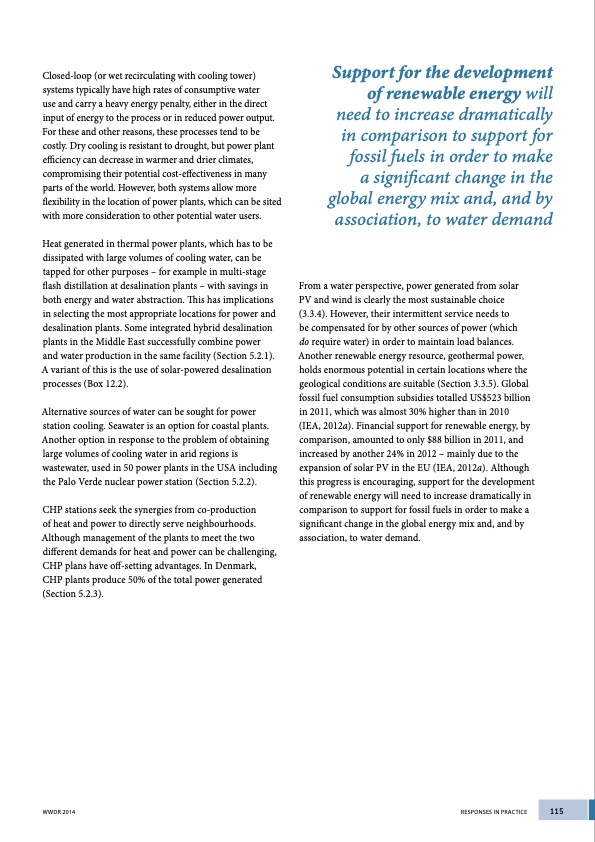
PDF Publication Title:
Text from PDF Page: 131
Closed-loop (or wet recirculating with cooling tower) systems typically have high rates of consumptive water use and carry a heavy energy penalty, either in the direct input of energy to the process or in reduced power output. For these and other reasons, these processes tend to be costly. Dry cooling is resistant to drought, but power plant efficiency can decrease in warmer and drier climates, compromising their potential cost-effectiveness in many parts of the world. However, both systems allow more flexibility in the location of power plants, which can be sited with more consideration to other potential water users. Heat generated in thermal power plants, which has to be dissipated with large volumes of cooling water, can be tapped for other purposes – for example in multi-stage flash distillation at desalination plants – with savings in both energy and water abstraction. This has implications in selecting the most appropriate locations for power and desalination plants. Some integrated hybrid desalination plants in the Middle East successfully combine power and water production in the same facility (Section 5.2.1). A variant of this is the use of solar-powered desalination processes (Box 12.2). Alternative sources of water can be sought for power station cooling. Seawater is an option for coastal plants. Another option in response to the problem of obtaining large volumes of cooling water in arid regions is wastewater, used in 50 power plants in the USA including the Palo Verde nuclear power station (Section 5.2.2). CHP stations seek the synergies from co-production of heat and power to directly serve neighbourhoods. Although management of the plants to meet the two different demands for heat and power can be challenging, CHP plans have off-setting advantages. In Denmark, CHP plants produce 50% of the total power generated (Section 5.2.3). Support for the development of renewable energy will need to increase dramatically in comparison to support for fossil fuels in order to make a significant change in the global energy mix and, and by association, to water demand From a water perspective, power generated from solar PV and wind is clearly the most sustainable choice (3.3.4). However, their intermittent service needs to be compensated for by other sources of power (which do require water) in order to maintain load balances. Another renewable energy resource, geothermal power, holds enormous potential in certain locations where the geological conditions are suitable (Section 3.3.5). Global fossil fuel consumption subsidies totalled US$523 billion in 2011, which was almost 30% higher than in 2010 (IEA, 2012a). Financial support for renewable energy, by comparison, amounted to only $88 billion in 2011, and increased by another 24% in 2012 – mainly due to the expansion of solar PV in the EU (IEA, 2012a). Although this progress is encouraging, support for the development of renewable energy will need to increase dramatically in comparison to support for fossil fuels in order to make a significant change in the global energy mix and, and by association, to water demand. WWDR 2014 RESPONSES IN PRACTICE 115PDF Image | Water and Energy

PDF Search Title:
Water and EnergyOriginal File Name Searched:
225741e.pdfDIY PDF Search: Google It | Yahoo | Bing
NFT (Non Fungible Token): Buy our tech, design, development or system NFT and become part of our tech NFT network... More Info
IT XR Project Redstone NFT Available for Sale: NFT for high tech turbine design with one part 3D printed counter-rotating energy turbine. Be part of the future with this NFT. Can be bought and sold but only one design NFT exists. Royalties go to the developer (Infinity) to keep enhancing design and applications... More Info
Infinity Turbine IT XR Project Redstone Design: NFT for sale... NFT for high tech turbine design with one part 3D printed counter-rotating energy turbine. Includes all rights to this turbine design, including license for Fluid Handling Block I and II for the turbine assembly and housing. The NFT includes the blueprints (cad/cam), revenue streams, and all future development of the IT XR Project Redstone... More Info
Infinity Turbine ROT Radial Outflow Turbine 24 Design and Worldwide Rights: NFT for sale... NFT for the ROT 24 energy turbine. Be part of the future with this NFT. This design can be bought and sold but only one design NFT exists. You may manufacture the unit, or get the revenues from its sale from Infinity Turbine. Royalties go to the developer (Infinity) to keep enhancing design and applications... More Info
Infinity Supercritical CO2 10 Liter Extractor Design and Worldwide Rights: The Infinity Supercritical 10L CO2 extractor is for botanical oil extraction, which is rich in terpenes and can produce shelf ready full spectrum oil. With over 5 years of development, this industry leader mature extractor machine has been sold since 2015 and is part of many profitable businesses. The process can also be used for electrowinning, e-waste recycling, and lithium battery recycling, gold mining electronic wastes, precious metals. CO2 can also be used in a reverse fuel cell with nafion to make a gas-to-liquids fuel, such as methanol, ethanol and butanol or ethylene. Supercritical CO2 has also been used for treating nafion to make it more effective catalyst. This NFT is for the purchase of worldwide rights which includes the design. More Info
NFT (Non Fungible Token): Buy our tech, design, development or system NFT and become part of our tech NFT network... More Info
Infinity Turbine Products: Special for this month, any plans are $10,000 for complete Cad/Cam blueprints. License is for one build. Try before you buy a production license. May pay by Bitcoin or other Crypto. Products Page... More Info
| CONTACT TEL: 608-238-6001 Email: greg@infinityturbine.com | RSS | AMP |